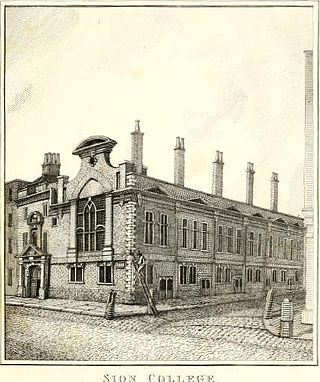Related Research Articles
Henry Condell was a British actor in the King's Men, the playing company for which William Shakespeare wrote. With John Heminges, he was instrumental in preparing and editing the First Folio, the collected plays of Shakespeare, published in 1623.
Elizabeth, Lady Coke, was an English court office holder. She served as lady-in-waiting to the queen consort of England, Anne of Denmark. She was the daughter of Thomas Cecil, 1st Earl of Exeter, and Dorothy Neville, and the granddaughter of William Cecil, 1st Baron Burghley. She was the wife of Sir William Hatton and later of Sir Edward Coke.

Sion College, in London, is an institution founded by royal charter in 1630 as a college, guild of parochial clergy and almshouse, under the 1623 will of Thomas White, vicar of St Dunstan's in the West.

Barbara Sidney, Countess of Leicester was a Welsh heiress, and the first wife of Robert Sidney, 1st Earl of Leicester. Her family connections tied her to prominent contemporary figures such as Sir Walter Raleigh.

Frederick Ulrich, Duke of Brunswick-Lüneburg, was prince of Wolfenbüttel from 1613 until his death.

St Laurence Pountney was a Church of England parish church in the Candlewick ward of the City of London. It was destroyed in the Great Fire of 1666, and not rebuilt.
King's Men personnel were the people who worked with and for the Lord Chamberlain's Men and the King's Men from 1594 to 1642. The company was the major theatrical enterprise of its era and featured some of the leading actors of their generation – Richard Burbage, John Lowin, and Joseph Taylor among other – and some leading clowns and comedians, like Will Kempe and Robert Armin. The company benefitted from the services of William Shakespeare, John Fletcher, and Philip Massinger as regular dramatists.
Anne Lykke was a Danish noblewoman and royal mistress of Christian, Prince Elect of Denmark.
Sir Thomas Cheek, Cheeke or Cheke was an English politician who sat in the House of Commons in every parliament between 1614 and 1653.
Bassingbourne Gawdy, of West Harling, Norfolk, was an English landowner, magistrate and Member of Parliament (MP).
SirBassingbourne Gawdy, of West Harling, Norfolk, was an English lawyer and judge, knight, and Member of Parliament.
Sir Robert Southwell (1563–1598), of Woodrising, Norfolk, was an English politician.
Mary (Dudley) Sutton, Countess of Home (1586–1644), was a landowner, living in England and Scotland.
Mary Gargrave was a courtier to Anne of Denmark.
Sir Henry Harington of Bagworth and Baltinglass, English and Irish landowner and soldier, known for his defeat at Arklow in 1599.
Philip Gawdy was an English landowner and letter writer.

Elizabeth, Lady K(i|y)tson born Lady Elizabeth Cornwallis was an English music patron. She came from East Anglia and married the owner of Hengrave Hall in Suffolk. The Kitsons also had a London house. They gave permanent employment to musicians.
Margaret Ratcliffe or Radcliffe or Radclyffe (1575-1599) was an English courtier.
Frances Southwell was an English courtier.
Harry Bristow Wilson was an English antiquarian.
References
- ↑ Isaac Herbert Jeayes, Letters of Philip Gawdy of West Harling, Norfolk, 1579-1616 (London, 1906), pp. xvi, 158-9.
- ↑ Joseph Lemuel Chester & George Armytage, Marriage Licences by the Bishop of London (London, 1887), p. 178.
- ↑ John Bruce, Calendar State Papers Domestic, 1634-1635 (London, 1867), pp. 98, 129-30.
- ↑ Harry Bristow Wilson, A History of the Parish of St. Laurence Pountney (London, 1831), p. 227: Will, TNA PROB 11/169/105.
- ↑ Norman Egbert McClure, Letters of John Chamberlain, vol. 2 (Philadelphia, 1939), p. 20 "a fine mincks".
- ↑ Robert Hovenden, Register of St James Clerkenwell (London, 1887) p. 44.
- ↑ Harry Bristow Wilson, A History of the Parish of St. Laurence Pountney (London, 1831), p. 227: John Nichols, History and Antiquities of Leicestershire, 2:2 (London, 1798), pp. 817-8.